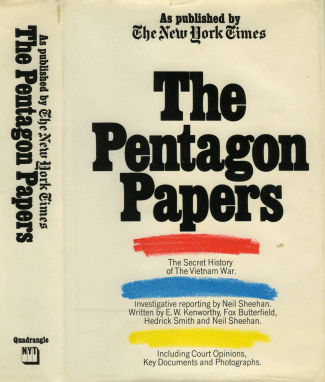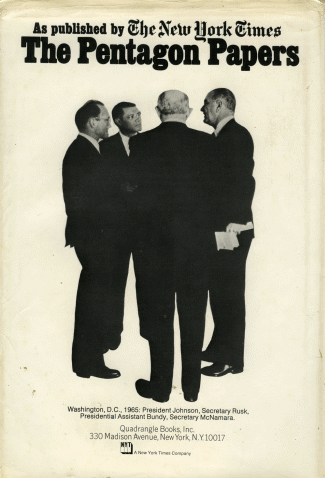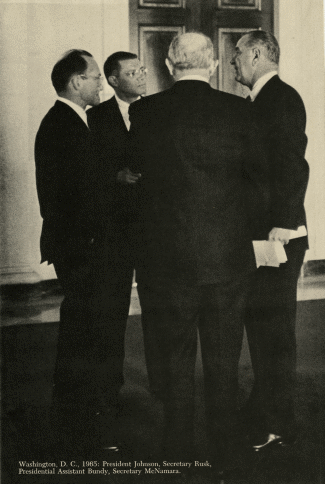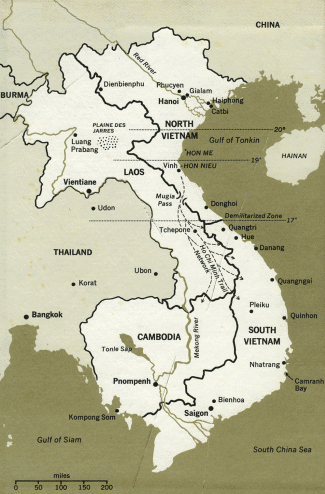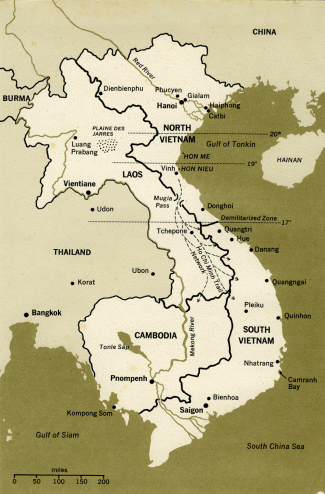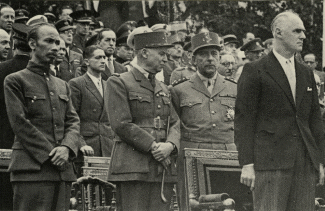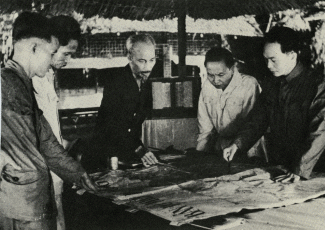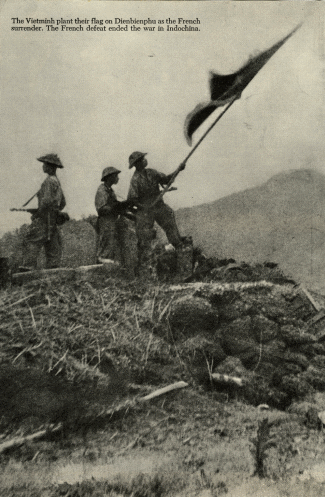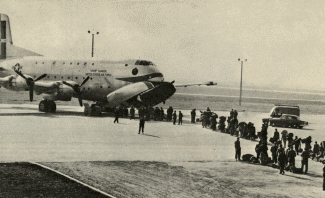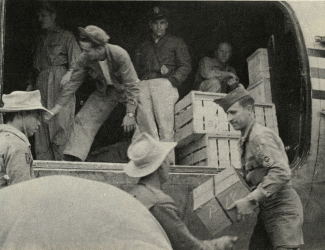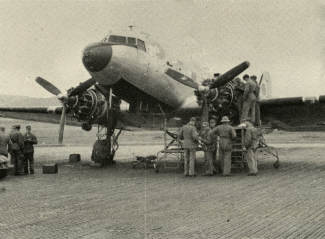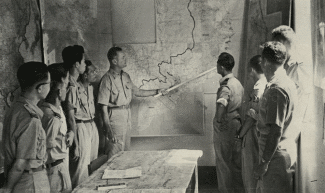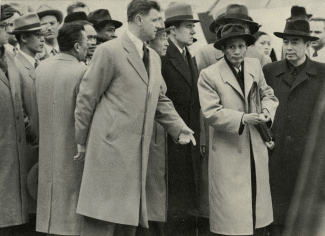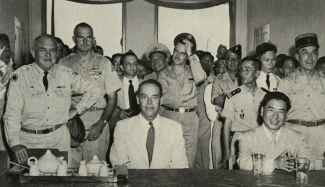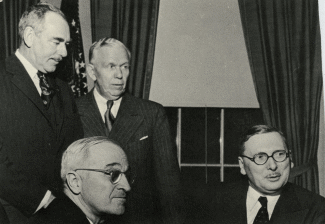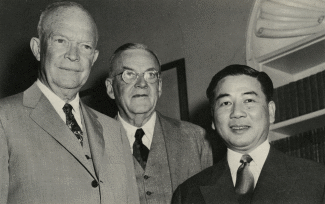PART 1 OF 4
Chapter 3: The Kennedy Years: 1961-1963
Highlights of the Period: 1961-1963The Pentagon study reaches no conclusion as to how the course of the Vietnam war might have changed if John F. Kennedy had lived -- but it sums up the Kennedy years as a time of significantly deepening U.S. involvement.
Here, arranged chronologically, are the highlights of those two and a half years:
1961
A national intelligence estimate reported that an "extremely critical period" for South Vietnam and the Saigon regime was "immediately ahead."
The President ordered 400 Special Forces soldiers and 100 other military advisers to South Vietnam, the study says. He also ordered a clandestine campaign of "sabotage and light harassment" in the North by South Vietnamese agents trained by the U.S.
A task force headed by Roswell L. Gilpatric proposed discussions with President Diem on the "possibility of a defensive security alliance" despite the violation of the Geneva accords. The President approved.
Vice President Lyndon B. Johnson, reporting on his mission to Saigon, said the U.S. must decide "whether to help these countries" or to "throw in the towel" and "pull back our defenses to San Francisco."
President Diem, in a letter to President Kennedy, asked for a "considerable" buildup in U.S. forces and a 100,000-man increase in the South Vietnamese army. He used "inflated infiltration figures" to support his contention of the Communist threat, the study says.
The White House agreed to finance a 30,000-man increase in South Vietnam's army.
The Joint Chiefs of Staff estimated that 40,000 U.S. servicemen would be needed to "clean up the Vietcong threat."
William P. Bundy, in a note to Secretary of Defense Robert S. McNamara, urged "early and hard-hitting" U.S. intervention. He gave this a 70 per cent chance of "arresting things," and estimated there was a 30 per cent chance that "we would wind up like the French in 1954; white men can't win this kind of fight."
A national intelligence estimate reported "little evidence" that the Vietcong rely on external supplies, the Pentagon account says.
General Taylor met with President Diem. He recommended a Mekong Delta flood-relief "task force, largely military in composition," including "combat troops" for protection. He recommended a 6,000-8,000-man U.S. force, warning that they "may expect to take casualties," but that they could be withdrawn or "phased into other activities."
He discounted the risk of a "major Asian war," and said the North was "extremely vulnerable to conventional bombing."
Mr. McNamara said he and the Joint Chiefs were "inclined to recommend" General Taylor's proposal although the "struggle may be prolonged."
General Taylor, in a message to President Kennedy, said a "U.S. military task force is essential."
Mr. McNamara and Mr. Rusk, in a joint memo, backed General Taylor's recommendations. They recommended, initially, "U.S. units of modest size" for "direct support" and "as speedily as possible"; they insisted that government reforms be a precondition.
The President approved the major recommendations. President Diem was said to be upset by the U.S. response. The demands for reforms were softened, and the insistence on American participation in decision-making was withdrawn.
1962
A military briefing paper for the President reported 948 U.S. servicemen were in South Vietnam by the end of November; 2,646 by the next January 9. There were also helicopter combat-support missions.
Mr. McNamara ordered planning for U.S. withdrawal, partly on the basis of what he called "tremendous progress," and also because of the difficulty of holding public support for American operations "indefinitely."
Michael V. Forrestal, a White House aide, reported to Kennedy that a long, costly conflict should be anticipated. He said that Vietcong recruiting was so effective that the guerrillas could do without infiltration from the North.
The U.S., by October, had 16,732 men in Vietnam. Planning for withdrawal continued, the study says, on the basis of "the most Micawberesque predictions" of progress.
Chapter 3: The Kennedy Years: 1961-1963by Hedrick Smith
The Pentagon's study of the Vietnam war concludes that President John F. Kennedy transformed the "limited-risk gamble" of the Eisenhower Administration into a "broad commitment" to prevent Communist domination of South Vietnam.
Although Mr. Kennedy resisted pressures for putting American ground-combat units into South Vietnam, the Pentagon analysts say, he took a series of actions that significantly expanded the American military and political involvement in Vietnam but nonetheless left President Lyndon B. Johnson with as bad a situation as Mr. Kennedy inherited.
'The dilemma of the U.S. involvement dating from the Kennedy era," the Pentagon study observes, was to use "only limited means to achieve excessive ends."
Moreover, according to the study, prepared in 1967-68 by Government analysts, the Kennedy tactics deepened the American involvement in Vietnam piecemeal, with each step minimizing public recognition that the American role was growing.
President Kennedy made his first fresh commitments to Vietnam secretly. The Pentagon study discloses that in the spring of 1961 the President ordered 400 Special Forces troops and 100 other American military advisers sent to South Vietnam. No publicity was given to either move.
Small as the numbers seem in retrospect, the Pentagon study comments that even the first such expansion "signaled a willingness to go beyond the 685-man limit on the size of the U.S. [military] mission in Saigon, which, if it were done openly, would be the first formal breach of the Geneva agreement." Under the interpretation of that agreement in effect since 1956, the United States was limited to 685 military advisers in Vietnam. Washington, while it did not sign the accord, pledged not to undermine it.
On May 11, 1961, the day on which President Kennedy decided to send the Special Forces, he also ordered the start of a campaign of clandestine warfare against North Vietnam, to be conducted by South Vietnamese agents directed and trained by the Central Intelligence Agency and some Americ'1n Special Forces troops. [See Document #20.]
The President's instructions, as quoted in the documents, were, "In North Vietnam ... [to] form networks of resistance, covert bases and teams for sabotage and light harassment." The American military mission in Saigon was also instructed to prepare South Vietnamese Army units "to conduct ranger raids and similar military actions in North Vietnam as might prove necessary or appropriate."
The Pentagon study reports that the primary target of the clandestine campaign against North Vietnam, and Laos as well, was to be "lines of communication" -- railroads, highways, bridges, train depots and trucks.
The study does not report how many agents were actually sent north, though documents accompanying it described some of the build-up and training of the First Observation Group, the main South Vietnamese unit conducting the covert campaign.
Within weeks of President Kennedy's May 11 decision, moreover, the North Vietnamese Government made repeated protests to the International Control Commission that its airspace and territory were being violated by foreign aircraft and South Vietnamese ground raids thrusting into the demilitarized zone along the border between the two Vietnams.
In July, 1961, Hanoi announced publicly that it had captured and was putting on trial three South Vietnamese participants in undercover operations who had survived the crash of a plane that was shot down, Hanoi said, while preparing to drop them into North Vietnam. The North Vietnamese, protesting formally to Britain and the Soviet Union -- the cochairmen of the 1954 Geneva conference on Vietnam -- described in detail what they said the survivors had disclosed about their American training and equipment.
Mr. Kennedy's May 11 orders, the study discloses, also called for infiltration of South Vietnamese forces into southeastern Laos to find and attack Communist bases and supply lines.
On Oct. 13, moreover, the President reportedly gave additional secret orders for allied forces to "initiate ground action, including the use of U.S. advisers if necessary," against Communist aerial resupply missions in the vicinity of Tchepone, in the southern Laotian panhandle.
The Pentagon study does not analyze these covert operations in detail, but it shows Mr. Kennedy's decisions as part of an unbroken sequence that built up to much more ambitious covert warfare against North Vietnam under President Johnson in 1964.
The analysts handling the Kennedy period put more stress, however, on the evolution of President Kennedy's decision in November, 1961, to expand greatly the American military advisory mission in Vietnam and, for the first time, to put American servicemen in combat-support roles that involved them increasingly in actual fighting.
In a cablegram to Washington on Nov. 18, cited in the study, Frederick E. Nolting Jr., the United States Ambassador in Saigon, described the significance attached to those moves. He said he had explained to President Ngo Dinh Diem of South Vietnam that the new roles of American servicemen "could expose them to enemy action."
"In response to Diem's question," Mr. Nolting continued, "[I] said that in my personal opinion these personnel would be authorized to defend themselves if attacked. I pointed out that this was one reason why the decisions were very grave from U.S. standpoints."
Questions for KennedyThe Pentagon study shows President Kennedy facing three main questions on Vietnam during his term of office: whether to make an irrevocable commitment to prevent a Communist victory; whether to commit ground combat units to achieve his ends; whether to give top priority to the military battle against the Vietcong or to the political reforms necessary for winning popular support.
President Kennedy's response during 34 months in office, as the Pentagon account tells it, was to increase American advisers from the internationally accepted level of 685 to roughly 16,000 to put Americans into combat situations -- resulting in a tenfold increase in American combat casualties in one year -- and eventually to inject the United States into the internal South Vietnamese maneuvering that finally toppled the Diem regime.
The judgment of the Pentagon study is that while President Kennedy's actions stopped short of the fundamental decision to commit ground troops, nonetheless, "the limited-risk gamble undertaken by Eisenhower had been transformed into an unlimited commitment under Kennedy." Later, more cautiously, the study says that Mr. Kennedy's policies produced a "broad commitment" to Vietnam's defense, giving priority to the military aspects of the war over political reforms.
The study also observes that the pervasive assumption in the Kennedy Administration was that "the Diem regime's own evident weaknesses -- from the 'famous problem of Diem as administrator' to the Army's lack of offensive spirit -- could be cured if enough dedicated Americans, civilians and military, became involved in South Vietnam to show the South Vietnamese, at all levels, how to get on and win the war."
President Kennedy and his senior advisers are described in the study as considering defeat unthinkable and assuming that the mere introduction of Americans would provide the South Vietnamese with what the authors call "the elan and style needed to win."
The description of the debates in the Kennedy Administration presented in the study are revealing -- particularly when the President decides against committing ground troops -- because they emerge, in effect, as a rehearsal for the planning in the Johnson era that led to outright war in 1965. Many of the same officials advanced many of the same arguments, and the intelligence community offered some of the same ominous forewarnings.
President Kennedy was told that sending ground troops would be a "shot in the arm" that would "spark real transformation" of the Southern Vietnamese Army. The Joint Chiefs of Staff calculated that, at worst, no more than 205,000 American soldiers would be required to cope not only with the Vietcong but also with North Vietnam and Communist China if they should intervene. Both military and civilian advisers contended that American bombing of the North -- even the mere threat of it -- would hold Hanoi and the other Communist nations at bay.
In secretly urging the first commitment of American ground troops to Vietnam in November, 1961, Gen. Maxwell D. Taylor, then the President's personal military adviser, discounted the risks of a major land war. In a private message to the President from the Philippines, on his way home from Saigon on Nov. 1, he said:
"The risks of backing into a major Asian war by way of SVN are present but are not impressive. NVN is extremely vulnerable to conventional bombing, a weakness which should be exploited diplomatically in convincing Hanoi to layoff SVN.
"Both the D.R.V. [Democratic Republic of (North) Vietnam] and the Chicoms would face severe logistical difficulties in trying to maintain strong forces in the field in SEA [Southeast Asia], difficulties which we share but by no means to the same degree. There is no case for fearing a mass onslaught of Communist manpower into SVN and its neighboring states, particularly if our airpower is allowed a free hand against logistical targets."
In General Taylor's recommendations for an initial commitment of 6,000 to 8,000 American ground troops, the account relates, he had a co-author, Walt W. Rostow, then the senior White House aide working on Southeast Asia.
On Nov. 5 Secretary of Defense Robert S. McNamara sent President Kennedy a memorandum stating that he and the Joint Chiefs of Staff were "inclined to recommend" General Taylor's proposal -- but with the significant warning that much greater troop commitments were likely in the future. [See Document #29.]
"The struggle may be prolonged and Hanoi and Peiping may intervene overtly," the McNamara memorandum told the President. It estimated that even so, "the maximum U.S. forces required on the ground in Southeast Asia will not exceed six divisions, or about 205,000 men."
The President eventually rejected this approach. But the Pentagon study comments that the ground-troop issue so dominated the discussions that Mr. Kennedy's ultimate decisions to approve the advisory build-up and the introduction of combat-support troops was made "without a careful examination" of precisely what it was expected to produce and how.
The study concludes that the Kennedy strategy was fatally flawed from the outset for political as much as for military reasons. It depended, the study notes, on successfully prodding President Diem to undertake the kind of political, economic and social reforms that would, in the slogan of that day, "win the hearts and minds of the people."
"The U.S. over-all plan to end the insurgency was on shaky ground on the GVN side," the study comments. "Diem needed the U.S. and the U.S. needed a reformed Diem."
It also says: "If he could not [reform], the U.S. plan to end the insurgency was foredoomed from its inception, for it depended on Vietnamese initiatives to solve a Vietnamese problem."
And in the end, the Pentagon account relates, the Kennedy Administration concluded that President Diem could not reform sufficiently and in 1963 abandoned him.
Abandoning President Diem was what Ambassador Elbridge Durbrow had suggested in September, 1960, [see Document # 16.] and again that December, shortly before Mr. Kennedy took office as President. Drawing on the Ambassador's reports, among others, a national intelligence estimate provided for Mr. Kennedy on March 28, 1961, gave a bleak appraisal of the situation in Vietnam:
"An extremely critical period for President Ngo Dinh Diem and the Republic of Vietnam lies immediately ahead. During the past six months the internal security situation has continued to deteriorate and has now reached serious proportions ...
"More than one-half of the entire rural region south and southwest of Saigon, as well as some areas to the north, are under considerable Communist control. Some of these areas are in effect denied to all government authority not immediately backed by substantial armed force. The Vietcong's strength encircles Saigon and has recently begun to move closer in on the city . . . .
"The deterioration in the position of the Diem Government reached a new extreme in November when army paratroop officers joined forces with a number of civilian oppositionists in a narrowly defeated attempt to overthrow Diem. On the surface, Diem's position appears to have improved somewhat since then ....
"However, the facts which gave rise to the coup attempt have not been seriously dealt with and still exist. Discontent with the Diem Government continues to be prevalent among intellectual circles and, to a lesser degree, among labor and business groups. There has been an increasing disposition within official circles and the Army to question Diem's ability to lead in this period. Many feel that he is unable to rally the people in the fight against the Communists because of his reliance on virtual one-man rule, his toleration of corruption extending even to his immediate entourage, and his refusal to relax a rigid system of public controls."
This assessment, the Pentagon study relates, echoed the themes and even some of the language of Ambassador Durbrow's cablegrams. One of these, on Sept. 24, 1960, suggested that if President Diem was unable to regain support through political and social reforms, "it may become necessary for U.S. Government to begin consideration alternative courses of action and leaders."
A Challenge for the U.S.However serious the problem in South Vietnam, the situation in Laos was far more critical. "The Western position was in the process of falling apart as Kennedy took office," the Pentagon account says.
And during the spring of 1961, when President Kennedy made his first series of Vietnam decisions, Laos -- not Vietnam -- was the dominant issue and largely determined how Vietnam should be handled, according to the Pentagon account.
The Eisenhower Administration had chosen to back rightwing elements in Laos, and by early 1961 they were reeling under Communist and neutralist attacks. President Kennedy chose to seek a political compromise and a military cease-fire rather than to continue to support the Laotian rightists.
Because of this shift in strategy in Laos, the Pentagon study says, the Kennedy Administration felt impelled to show strength in Vietnam to reassure America's allies in Asia.
In what the Administration saw as a global power competition with the Soviet Union, the account notes, Washington thought it dangerous to give ground too often. Summing up the Administration's reasoning, the author writes: "After the U.S. stepped back in Laos, it might be hard to persuade the Russians that we intended to stand firm anywhere if we then gave up on Vietnam."
Moreover, the Kennedy Administration sensed a particular challenge in the declaration by the Soviet Premier, Nikita S. Khrushchev, on Jan. 6, 1961, that Moscow intended to back "wars on national liberation" around the world. In response, counterinsurgency -- as strategy against guerrilla war became known -- grew to be a primary preoccupation of the Kennedy White House, as a steady flow of Presidential decision papers testifies.
"Vietnam was the only place in the world where the Administration faced a well-developed Communist effort to topple a pro-Western government with an externally aided pro-Communist insurgency," the Pentagon study comments. "It was a challenge that could hardly be ignored."
On April 12 Mr. Rostow, the senior White House specialist on Southeast Asia and a principal architect of counterinsurgency doctrine, put Vietnam directly before President Kennedy with a memorandum [see Document #22] asserting that the time had come for "gearing up the whole Vietnam operation." He proposed a series of moves that the study calls "pretty close to an agenda" for the Kennedy Administration's first high-level review of Vietnam. Among other things Mr. Rostow proposed these measures:
• "The appointment of a full-time first-rate backstop man in Washington."
• "A possible visit to Vietnam in the near future by the Vice President."
• "The raising of the MAAG [Military Assistance Advisory Group] ceiling, which involves some diplomacy, unless we can find an alternative way of introducing into the Vietnam operation a substantial number of Special Forces types."
• "Setting the question of extra funds for Diem."
• "The tactics of persuading Diem to move more rapidly to broaden the base of his Government, as well as to decrease its centralization and improve its efficiency."
Virtually all the Rostow proposals eventually became policy except his suggestion for a "first-rate backstop man." His candidate, the study notes, was Brig. Gen. Edward G. Lansdale, a long-time Central Intelligence Agency operative who was close to President Diem and who in 1961 was in charge of "special operations" for the Pentagon. The State Department blocked his appointment, the study reports.
On April 20 -- the day after the collapse of the Bay of Pigs invasion of Cuba -- President Kennedy ordered a quick review of the Vietnam situation. As quoted by Secretary McNamara, the President's instructions were to "appraise . . . the Communist drive to dominate South Vietnam" and "recommend a series of actions (military, political and/ or economic, overt and/ or covert) which, in your opinion, will prevent Communist domination of that country."
The task force, headed by Roswell L. Gilpatric, Deputy Secretary of Defense, turned in its report on April 27.
The report, quoted in the Pentagon study, recommended a 100-man increase in the American military advisory mission in Saigon, more American arms and aid for the Vietnamese regional forces known as the Civil Guard, the release of funds for a previously approved expansion of the South Vietnamese Army and the dropping of earlier conditions that President Diem undertake political and social reforms in return. Allied efforts, the report said, should be infused with a sense of urgency to impress friends and foes alike that "come what may, the U.S. intends to win this battle." The emphasis was in the original report.
Even before the report was submitted, it was overtaken by events: The Laotian crisis was at its peak. President Kennedy met with the National Security Council on April 26 to decide whether to send troops into Laos. Late that night the Joint Chiefs of Staff alerted the commander in chief of Pacific forces, Adm. Harry D. Felt, "to be prepared to undertake air strikes against North Vietnam, and possibly southern China," the account reports.
Overnight the Vietnam recommendations changed. "As insurance against a conventional invasion of South Vietnam" through the eastern, mountainous portions of Laos, the Gilpatric task force recommended quick expansion of the South Vietnamese Army by two divisions -- 40,000 men -- plus the first major input of American troops, as training forces, according to the Pentagon study.
The April 28 "Laos annex," the narrative recounts, called for "a 1,600-man [American] training team for each of the two new [South Vietnamese] divisions, plus a 400-man Special Forces contingent to speed up counterinsurgency forces: a total of 3,600 men."
On April 29 -- described in the narrative as a day of "prolonged crisis meetings at the White House" -- Admiral Felt was alerted to prepare to move one American combat brigade of 5,000 men with air elements to northeastern Thailand and another to Danang, on the South Vietnamese coast, as a threat to intervene in Laos. "Decision to make these deployments not firm," the Joint Chiefs of Staff cabled Admiral Felt. The tactics were directly related to the Laos crisis.
Acting on Vietnam that day, the study reports, President Kennedy approved the modest 100-man increase in the American advisory mission and a few other steps suggested in the first Gilpatric task force's report.
"The only substantial significance that can be read into these April 29 decisions," the analyst writes, "is that they signaled a willingness to go beyond the 685-man limit of the U.S. military mission in Saigon." Publicity would have entailed "the first formal breach of the Geneva agreements," the study says, so the move was kept quiet.
By May I the acute fever of the Laos crisis had eased, the account goes on, and there was a "strong sense ... that the U.S. would not go into Laos: that if the cease-fire failed, we would make a strong stand, instead, in Thailand and Vietnam."
Vietnam planning was directly affected. The State Department drafted the first of several revisions to tone down the Gilpatric task force's recommendations. When the task-force report finally went before the National Security Council on May 9, the study recounts, the State Department had largely prevailed. Shortly before that the White House announced that Vice President Johnson was leaving within days for a trip to Saigon and other Asian capitals.
The final task-force report, quoted in the Pentagon account, recommended the deployment of 400 Special Forces soldiers and an immediate Pentagon study of a further build-up "in preparation for possible commitment of U.S. forces to Vietnam, which might result from an N.S.C. decision following discussions between Vice President Johnson and President Diem." The idea of sending 3,200 other soldiers right away was dropped.
In place of a Pentagon proposal made on May 1 for unilateral American intervention in Vietnam if that became necessary to "save the country from Communism," the final report by the Gilpatric task force proposed a new "bilateral arrangement with Vietnam."
"On the grounds that the Geneva accords have placed inhibitions upon Free World action while at the same time placing no restrictions upon the Communists," the report said, "Ambassador Nolting should be instructed to enter into preliminary discussions with Diem regarding the possibility of a defensive security alliance despite the inconsistency of such action with the Geneva accords .... Communist violations, therefore, justify the establishment of the security arrangements herein recommended."
A Sterner ObjectiveOn May 11, two days after Vice President Johnson's departure for Saigon, President Kennedy made his decisions. As recorded in National Security Action Memorandum 52, a copy of which accompanies the Pentagon study, the American objective was stated more bluntly and more ambitiously than in typical public pronouncements. The memorandum said the American objective was "to prevent Communist domination of South Vietnam," whereas six days earlier President Kennedy himself spoke at a news conference of a vaguer desire "to assist Vietnam to obtain its independence."
The memorandum also specified measures that were not disclosed to the public: Presidential approval for the deployment of 400 Special Forces troops, for Ambassador Nolting to start negotiations on "a new bilateral arrangement with Vietnam" and for the initiation of a covert-warfare campaign against North Vietnam.
The one step, in the Pentagon analyst's view, that involved the United States more than the President's public statements suggested was the decision to send Special Forces. "Obviously the President was sold on their going," the study comments, "and since the Vietnamese Special Forces were themselves supported by C.I.A. rather than the regular military-aid program, it was possible to handle these troops covertly."
According to the documentary record, President Kennedy's specific orders on covert warfare called for these steps:
• "Dispatch ... agents to North Vietnam" for intelligence gathering.
• "Infiltrate teams under light civilian cover to southeast Laos to locate and attack Vietnamese Communist bases and lines of communications."
• "In North Vietnam, using the foundation established by intelligence operations, from networks of resistance, covert bases and teams for sabotage and light harassment."
• "Conduct overflights for dropping of leaflets to harass the Communists and to maintain morale of North Vietnamese population, and increase gray [unidentified-source] broadcasts to North Vietnam for the same purposes."
• Train "the South Vietnamese Army to conduct ranger raids and similar military actions in North Vietnam as might prove necessary or appropriate."
The documents also show that Mr. Kennedy approved plans "for the use in North Vietnam operations of civilian air crews of American and other nationality, as appropriate, in addition to Vietnamese." The plans, quoted in full in the final report of the Gilpatric task force, designate the South Vietnamese Army's First Observation Group, stationed at Nhatrang, as the main unit for carrying on unconventional warfare in Laos, South Vietnam and North Vietnam.
In July, 1961, General Lansdale submitted to General Taylor, the President's military adviser, a preliminary report on preparations for this clandestine warfare. By that time, the report said, the First Observation Group had "some limited operations in North Vietnam and some shallow penetrations into Laos." [See Document #22.]
The Lansdale report stated, however, that most of the unit's operations had been directed against the Vietcong in South Vietnam and that this was being changed to focus it entirely on North Vietnam and Laos -- "denied areas," in official terminology.
"The plan is to relieve the group from these combat assignments [against the Vietcong] to ready its full strength for denied-areas missions," General Lansdale said. As of July 6, the unit was to be expanded to 805 men from 340. "Personnel are volunteers who have been carefully screened by security organizations," General Lansdale said. "Many are from North Vietnam. They have been trained for guerrilla operations at the group's training center at Nhatrang."
In addition, the Lansdale report said, 400 selected South Vietnamese soldiers, 60 montagnard tribesmen and 70 civilians were being formed into "additional volunteer groups, apart from the First Observation Group, for similar operations." The general listed 50 Americans -- 35 from the Defense Department and 15 from the C.I.A. -- engaged in training these groups and preparing other South Vietnamese intelligence and psychological-warfare operations. According to the Pentagon study, these were to be augmented by some of the 400 Special Forces soldiers President Kennedy ordered to the field on May 11.
The study does not report on the actual operations of the units during the Kennedy years.
Bernard Fall, in his history "The Two Vietnams," published in 1963, described the organization of the First Observation Group into 15-man combat teams and 24-man support teams. "One such unit was captured near Ninhbinh (180 miles north of the 17th Parallel) in July, 1961, when its aircraft developed engine trouble," Mr. Fall reported.
In July the Hanoi radio, as monitored by the United States Government, carried several English-language broadcasts on the incident, saying that North Vietnam had shot down a plane encroaching on its airspace and describing a number of American-made items to try to authenticate the plane's origin. According to the broadcasts, the plane was marked in red letters "C-47," the oil tank "Douglas Aircraft" and the radio apparatus "Bendix Radio, Baltimore, U.S.A.," and some of the 10 men aboard carried "Colt" automatics. The generator was marked "Signal Corps U.S. Army," one broadcast said.
The North Vietnamese Government announced plans to try three survivors on charges of sabotage and espionage, saying that they confessed to having been trained by Americans who gave them a map and traced out their flight route over North Vietnam. Hanoi protested the incident formally to Britain and the Soviet Union, as co-chairmen of the 1954 Geneva conference on Vietnam, asserting that since May 13, 1961 -- two days after President Kennedy's orders were issued -- the "U.S.-Diem regime" had "continuously carried out espionage and provocative acts against the North."
The North Vietnamese Foreign Minister described the C-47 incident as "an extremely impudent violation of the Geneva agreements." During July and August the North Vietnamese also broadcast descriptions of the build-up of the First Observation Group and the American organization and training of that unit, with details that corresponded almost exactly with the Lansdale report.
The North Vietnamese Government also formally protested several times to the International Control Commission that South Vietnamese units had conducted raids into the demilitarized zone separating the two Vietnams.
On Nov. 1 The New York Times carried a dispatch from Saigon quoting informants as reporting disaffection in North Vietnam and citing as evidence the sabotaging of an industrial plant at Vinh on Aug. 11 and other similar incidents.
Diem at the FulcrumPresident Kennedy's decision in May deferred -- but did not settle -- the issue of combat troops for South Vietnam. Throughout the summer and fall of 1961 the Administration's debate on that crucial matter was significantly affected by the attitude of President Diem, according to the Pentagon account. Initially, it relates, Vice President Johnson found the South Vietnamese leader reluctant; in midsummer he warmed to the idea somewhat; by fall he was appealing to the United States to become a co-belligerent.
The Vietnam troop decisions were also affected by the confrontation with the Soviet Union over Berlin. At his meeting in Vienna with Premier Khrushchev in June, President Kennedy managed to strike a general bargain to seek neutralization in Laos. But the Soviet leader applied pressure on the Berlin issue by threatening to sign a peace treaty with East Germany, making Western access to West Berlin extremely vulnerable. The tension on this issue mounted -- and overshadowed developments in Southeast Asia -- until, on Oct. 17, Premier Khrushchev dropped the idea of the peace treaty with East Germany.
Vice President Johnson, on his whirlwind mission through Asia to bolster the confidence of America's allies, met with President Diem on May 12. According to an embassy report of their meeting, when Mr. Johnson raised the possibility of sending American combat units to Vietnam or working out a bilateral defense treaty, he found Mr. Diem uninterested. The embassy report quoted President Diem as saying he wanted American combat troops only in the event of an open invasion.
In his private report to President Kennedy on May 23, the Vice President painted American alternatives in Asia in blacks and whites, giving Thailand and Vietnam pivotal significance. "We must decide whether to help these countries to the best of our ability," he declared, "or throw in the towel in the area and pull back our defenses to San Francisco and a 'Fortress America' concept." [See Document #21.]
Nonetheless, alluding to President Diem's response on the troop question, Mr. Johnson told Mr. Kennedy: "Asian leaders -- at this time -- do not want American troops involved in Southeast Asia other than on training missions .... This does not minimize or disregard the probability that open attack would bring calls for U.S. combat troops."
If this seemed to close the issue for President Kennedy, as the study indicates, it was not the last word from President Diem. Responding to a suggestion from Vice President Johnson, the South Vietnamese leader spelled out his military proposals in a letter to President Kennedy on June 9.
The letter, quoted extensively in the Pentagon account, urged a major expansion of the South Vietnamese Army, from 170,000 to 270,000 men, accompanied by "considerable" United States build-up with "selected elements of the American armed forces." President Diem said that the increases were needed "to counter the ominous threat" of Communist domination -- a threat that he documented by what the study calls "inflated infiltration figures."
The plea for "selected elements of the American armed forces," according to the Pentagon narrative, sounded "very much like" a request for the kind of forces that the Defense Department had proposed in April and that the American advisory mission in Saigon was urging in midsummer.
The real interest of the Joint Chiefs and other military officers, the account says, was "in getting U.S. combat units into Vietnam, with the training mission a possible device for getting this accepted by Diem" and by civilian leaders in Washington.
The White House, preoccupied by Berlin, sidestepped the issue by agreeing in August to finance a much more modest increase in the Vietnamese Army -- 30,000 men -- and by postponing any build-up of American advisers, according to the study.
Moreover, the writer suggests that the White House was already developing other ideas about Southeast Asia. During the summer discussions, Mr. Rostow once again produced proposals that, in the study's words, were a "quite exact" prescription for President Kennedy's decisions in the fall. In what is described in the account as a handwritten note to Secretary McNamara on a piece of scratch paper, probably passed by hand during a meeting about June 5, Mr. Rostow said:
"Bob:
"We must think of the kind of forces and missions for Thailand now, Vietnam later.
"We need a guerrilla deterrence operation in Thailand's northeast.
"We shall need forces to support a counterguerrilla war in Vietnam:
"aircraft
"helicopters
"communications men
"special forces
"militia teachers
"etc.
"WWR"
The emphasis on deterrence was Mr. Rostow's.
In late fall President Diem jolted the Kennedy Administration into its most urgent consideration of the troop issue -- and its most significant military decisions -- with a sudden, secret request for the bilateral defense treaty he previously spurned.
On Sept. 29 the study recounts, Mr. Diem had a gloomy meeting with American officials, and Ambassador Nolting sent Washington this cablegram:
"Diem asked for bilateral defense treaty. Large and unexplained request. Serious. Put forward as result of Diem's fear of outcome of Laos situation, SVN vulnerability to increased infiltration, feelings that SEATO action would be inhibited by U.K. and France in the case of SVN as in Laos ....
"Our reaction is that the request should be seriously and carefully treated to prevent feeling that U.S. is not serious in intention to support SVN. But see major issues including overriding Article 19, Geneva accords, possible ratification problems as well as effect on SEATO.
"Diem's request arises from feeling that U.S. policy on Laos will expose his flank [to] infiltration and lead to large-scale hostilities in SVN. So seeking a stronger commitment than he thinks he has now through SEATO."
Admiral Felt, the Pacific commander, who was also present at the Sept. 29 meeting, cabled a fuller report several days later saying that President Diem wanted not only a treaty but also an accelerated American "military build-up." Specifically, Admiral Felt said, the President pressed for a "large increase in advisers of all types" and American tactical air squadrons to help break up the larger Vietcong units that had recently been massing for attacks.
The Felt message explained that the stepped-up scale of combat in Vietnam was worrying President Diem as much as the threat of infiltration or attack from the Laotian side, if not more. It added: "Diem said VC now able to assemble large units, had extensive radio net, operating in one or more battalions with heavy arms capable of raiding principle cities in provinces .... Could enter a city, burn out stores, attack leaders, withdraw."
The Pentagon narrative explains that the Vietcong, now believed to be 17,000 strong, had nearly tripled the level of their attacks to 450 a month in September.
"The most spectacular attack, which seems to have had a shattering effect in Saigon," the writer goes on, "was the seizure of Phuocthanh, a provincial capital only 55 miles from Saigon," where the Vietcong held the town most of the day and publicly beheaded the province chief, departing before the South Vietnamese Army arrived.
For Washington the situation had become more alarming than it was in the spring. Then Laos was the primary cause of Vietnam's jitters. "This time," the study comments, "the problem was not directly Laos, but strong indications of moderate deterioration of Diem's military position and very substantial deterioration of morale in Saigon."
Even before President Diem's request for a treaty, momentum for American intervention in Southeast Asia had been mounting.
By early October, the Pentagon papers recount, several proposals had emerged: The Joint Chiefs of Staff advocated allied intervention to seize and hold major portions of Laos, mainly to protect the borders of South Vietnam and Thailand; the "Rostow proposal" urged sending a force of about 25,000 men from the Southeast Asia Treaty Organization into Vietnam to try to guard the border with Laos; and several other plans suggested putting American forces into the Vietnamese Central Highlands or the port of Danang, with or without a training mission.
In the bureaucratic maneuvering that led up to the important National Security Council meeting of Oct. 11, a significant new element was injected.
For the first time, the study notes, a proposal was put before President Kennedy urging that the United States accept "as our real and ultimate objective the defeat of the Vietcong." The analyst says this was suggested in a compromise paper drafted hastily by U. Alexis Johnson, Deputy Under Secretary of State. The paper said that "three divisions would be a guess" on the number of American troops needed but that a more precise estimate would be forthcoming from the Joint Chiefs of Staff.
The study describes this as a "somewhat confusing" blend of earlier proposals by Mr. Rostow and the Joint Chiefs of Staff, put together on Oct. 10. "It was pretty clear," the account continues, "that the main idea was to get some American combat troops into Vietnam, with the nominal excuse for doing so quite secondary."
The Joint Chiefs provided a supplemental note estimating "that 40,000 U.S. forces will be needed to clean up the Vietcong threat" and that 128,000 additional soldiers would be sufficient to cope with possible North Vietnamese or Chinese Communist intervention. The note, which accompanies the historical study, cited the Berlin crisis as another strain on American military manpower and urged "a step-up in the present mobilization, possibly of major proportions."
A third paper, which the narrative terms notable for its candor, also advocated "early and hard-hitting" intervention in Vietnam. This paper, a note to Secretary McNamara from William P. Bundy, Acting Assistant Secretary of Defense, said:
"It is really now or never if we are to arrest the gains being made by the Vietcong. Walt Rostow made the point yesterday that the Vietcong are about to move, by every indication, from the small-unit basis to a moderate battalion-size basis. Intelligence also suggests that they may try to set up a provisional government' ... in the very Kontum area into which the present initial plan would move SEATO forces. If the Vietcong movement 'blooms' in this way, it will almost certainly attack all the back-the-winner sentiment that understandably prevails in such cases and that beat the French in early 1954 and came within an ace of beating Diem in early 1955."
Mr. Bundy bluntly put the odds as he saw them:
"An early and hard-hitting operation has a good chance (70 per cent would be my guess) of arresting things and giving Diem a chance to do better and clean up . . . It all depends on Diem's effectiveness, which is very problematical. The 30 per cent chance is that we would wind up like the French in 1954; white men can't win this kind of fight.
"On a 70-30 basis, I would myself favor going in. But if we let, say, a month go by before we move, the odds will slide ... down to 60-40, 50-50 and so on."
The italics are Mr. Bundy's.
The intelligence community provided what the study calls a "conspicuously more pessimistic (and more realistic)" assessment than the formal recommendations of the Pentagon or Mr. Rostow. In spite of all the American worry about infiltration into South Vietnam through Laos, a special national intelligence estimate on Oct. 5 reported "that 80-90 per cent of the estimated 17,000 VC had been locally recruited, and that there was little evidence that the VC relied on external supplies," according to the Pentagon account.
The intelligence estimate also included a warning about the kind of enemy shrewdness and tenacity that became reality. The estimate, drafted while the Administration was thinking primarily of SEATO -- rather than unilateral American -- intervention, forecast:
"The Communists would expect worthwhile political and psychological rewards from successful harassment and guerrilla operations against SEATO forces. The D.R.V. would probably not relax its Vietcong campaign against the GVN [Government of (South) Vietnam] to any significant extent. Meanwhile, Communist strength in south Laos would probably be increased by forces from North Vietnam to guard against an effort to partition Laos. . . . The Soviet airlift would probably be increased with a heavier flow of military supply into south Laos .... "
Confronted with such conflicting advice, President Kennedy decided to send General Taylor to Saigon. According to minutes of the National Security Council meeting on Oct. 11, quoted in the Pentagon account, the general was instructed to consider three strategies:
• Bold intervention to "defeat the Vietcong," using up to three divisions of American troops.
• Sending "fewer U.S. combat forces" to Vietnam, not to crush the insurgency but "for the purpose of establishing a U.S. 'presence' in Vietnam."
• "Stepping up U.S. assistance and training of Vietnam units, furnishing of more U.S. equipment, particularly helicopters and other light aircraft, trucks and other ground transport" -- short of using American combat forces.
The minutes said President Kennedy was to announce the Taylor mission, at an afternoon news conference, "as an economic survey." But, the account says, the President did "not make the hardly credible claim that he was sending his personal military adviser to Vietnam to do an economic survey." After a vaguely worded announcement, the narrative relates, President Kennedy was "noncommittal when asked whether Taylor was going to consider the need for combat troops."
Even before General Taylor and his party could leave Washington, the Diem Government had sent new and urgent requests for American combat troops. Ambassador Nolting reported to Washington on Oct. 13 that Nguyen Dinh Thuan, the Vietnamese Acting Defense Minister, had requested: "U.S. combat units or units to be introduced into SVN as 'combat trainer units' ... Wanted a symbolic U.S. strength near the 17th [Parallel] to prevent attacks there, free own forces there. Similar purpose station U.S. units in several provincial seats in Central Highlands. . . . Thuan said first step quicker than [defense] treaty and time was of the essence. Thuan said token forces would satisfy SVN and would be better than treaty." [See Document #25.]
The South Vietnamese Government's state of alarm was communicated by Mr. Nolting's additional report that Saigon was considering asking Nationalist China "to send one division of combat troops in the southwest." Ambassador Nolting said he had tried to discourage this approach.
The Pentagon study goes on to report that Administration officials effectively squelched press speculation about the troop question with carefully managed news leaks at this point.
It cites a dispatch on Oct. 14 in The New York Times reporting that military leaders, including General Taylor, were reluctant to send combat units to Vietnam and that this question was "near the bottom of the list" of things the general would consider.
From the way the dispatch was handled, the account says, it clearly "came from a source authorized to speak for the President, and probably from the President himself." He adds that "in the light of the recommendations quoted throughout this paper, and particularly most of the staff papers ... that led up to the Taylor mission, most of this was simply untrue." But he concludes: "The Times story had the apparently desired effect. Speculation about combat troops almost disappeared from news stories."
